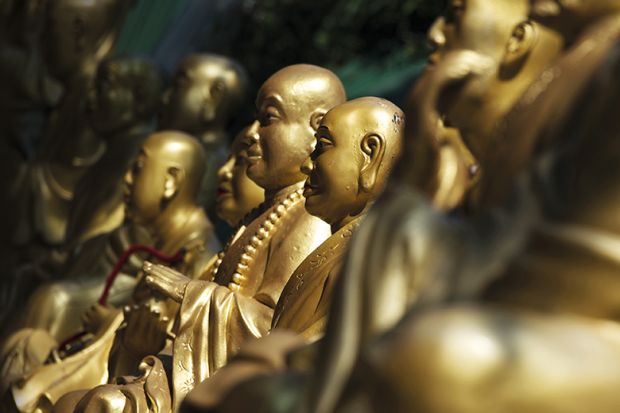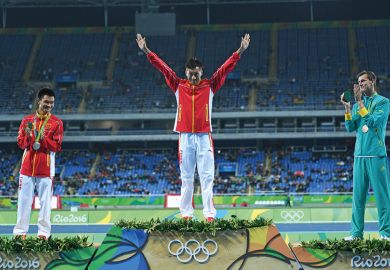Browse the full Times Higher Education Asia-Pacific University Rankings 2018 results
People cannot resist the lure of gold. In the 1850s, about 40,000 Chinese flocked to Australia to mine for wealth-creating treasure, swelling Australia’s population by about 10 per cent. There has been a similar spike in recent decades, this time in pursuit of 21st-century treasure: advanced learning and innovation. Such fervour has enriched people, institutions and countries.
But over the next 20 years, things might start to look a little different. China will reform to better govern and leverage the world’s biggest higher education system. Australia will worry about whether its globally mature system will flourish, hold steady or be swamped. These shifting dynamics carry implications for global higher education.
So it is timely to reflect on the shape of things to come. Here we consider eight issues that need addressing to help shape productive futures.
Improve the story
Higher education needs to build better public narratives. Most information available focuses on research and institutional brand, paying too little attention to the educational experience and broader community value. Although higher education has expanded, it still fails to reach all the people who might benefit from it.
Pioneering better narratives would help to build engagement. Studies of alumni five years after graduating, which were complex to undertake just a decade ago, are now routine for technology companies, making it simple to chart the life opportunities and adventures created by universities. What’s happened to those thousands of graduates Australia has educated for China? What unique benefits have been forged through bilateral academic exchanges? Creating new stories to answer such questions will help Australia and China to understand the enormous joint value that they create through higher education.
Look beyond the money
It is time for Australia to start seeing “international education” as more than a cash cow. Recent Australian government figures reveal that there are 509,610 international students in the country, representing a 16 per cent growth since 2017 and providing A$32 billion (£17.6 billion) to the economy. There was also a 16 per cent rise in the number of Chinese students. This situation has caused some alarm in Australia, and for client markets it signals system leakage and inadequacy. Sound future prospects rest on much broader thinking about the larger and long-term value being created. How have governments, universities and graduates parlayed the cash from tuition fees into economic development? What broader sustainable returns are being created?
Nurture relationships
Attention must be paid to emerging relationship dynamics. China was still receiving aid from wealthy countries until just a decade ago, so the idea of “China as buyer” and “Australia as seller” is quite new. Yet China has indeed emerged as an international education powerhouse. In 2017 it enrolled close to 500,000 foreign students, and it now supports many excellent universities. China has been Australia’s major trading partner during the living memory of most higher education students, yet surprisingly few Australians take full degrees in China. Antipodean families, governments and businesses should sponsor more students to head north in search of academic treasure. Savvy economists should contrive means to open up this world of lifetime returns. Perhaps a borderless income-contingent student loan?
Log in together
China and Australia should build shared online education platforms. Online education will further augment campus-based learning, rivalling aeroplanes as crucial technologies for international education. Smarter platforms will create innovative hybrid forms of learning, although reforming student assessment remains a major bottleneck. Sponsored platforms open lifelong learning, boosting all kinds of engagement. Surely Australian and Chinese universities can exploit online options to develop more interconnected education. Time for Australia to get on board the Chinese Mooc boom.
Build research bonds
Sino-Australian research partnerships need to be deepened. Substantial research engagements are the platforms for any prosperous future. Truly simpatico partnerships take shape over decades, so it is understandable that Australia’s baby boomer-heavy research leaders did not form deep intellectual bonds with China during their doctoral training and that Chinese academics make up only 5 per cent of Australia’s academic workforce. But today it is easy to delve beneath superficial linguistic complexities to create meaningful connections. And it is timely as China creates patterns of investment in research and development that are reshaping the world. Researchers, universities and funding agencies have a profound role to play in energising future engagements, as does the commercial world. Such intellectual substrate is a substantial hedge and source of value.
Refresh the PhD programme
New doctoral options are needed. PhDs do not just staff and run universities but also most of the rest of the advanced economy. To outsiders, the “PhD programme” might seem entrenched and deeply considered. But from an educational perspective, it is young, immature and ill-defined. China trains five times the number of PhD students that it did just two decades ago, and twice as many as Australia. There are substantial opportunities for China and Australia to design distinctively value-adding PhDs. Well-designed and deeply interconnected programmes underwrite decades of academic and broader growth. It is hard to find a better investment than excellent doctoral education. As part of this work, Australia should fund a large number of doctoral students to spend a period of months or a year in China.
Talk at the top
Dialogue between university leaders is essential. Although Chinese wealth contributes substantially to Australian universities’ revenues, there are no Chinese senior leaders at Australia’s institutions, and very few from Asia at all. How many leaders speak the home language of about 25 per cent of their students? What kind of deep bilateral management exchanges are available to help leaders experience each other’s countries? Although various leadership development platforms exist, these just scratch the surface. Transnational dialogues, training and transfers are urgently needed.
Cultural engagement
Both China and Australia need to know much more about each other’s culture. In Australia, the 14 Confucius Institutes and 67 Confucius Classrooms play this kind of role, operating as joint ventures between Chinese and Australian institutions. Could this partnership model be used to augment Australia’s cultural diplomacy? Given the size of bilateral investment, there seems value in scaling the 40-plus Australian Studies Centres across China, expanding their work to touch many broader facets of Australia’s society, government and economy.
What might acting on the issues we have raised mean for higher education in Australia, China and the world more widely?
Taking them seriously would imply much clearer public understanding of universities, mature perspectives of the value created by international education, more foreigners studying in China, more interconnected learning, deeper research partnerships, doctoral graduates with more international literacy, universities led by people with global experience, and broader cultural engagement. Looks like a changed political economy and a productive exemplar for global higher education.
People love hunting for treasure. Tomorrow’s treasure involves more than digging for gold or rare earth minerals. Devising novel designs for Chinese and Australian higher education carries the potential to uncover substantially more value. Building on 40 years of shared growth, together these two countries have an amazing opportunity to jump ahead in unexpected, inspiring and unique ways.
Hamish Coates is tenured professor at Tsinghua University’s Institute of Education and deputy director of Tsinghua’s Global Research Centre for the Assessment of College and Student Development.
Zhou Zhong is associate professor at Tsinghua University’s Institute of Education and associate dean of Tsinghua’s International Office of Cooperation and Exchange.
Register to continue
Why register?
- Registration is free and only takes a moment
- Once registered, you can read 3 articles a month
- Sign up for our newsletter
Subscribe
Or subscribe for unlimited access to:
- Unlimited access to news, views, insights & reviews
- Digital editions
- Digital access to THE’s university and college rankings analysis
Already registered or a current subscriber?









